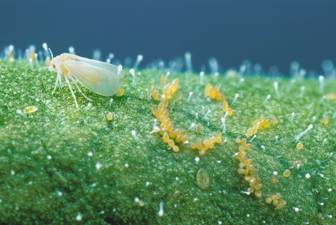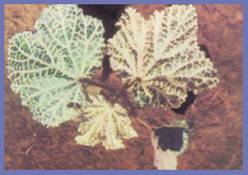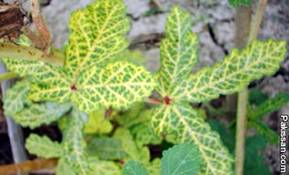Bhendi (Abelmoschus esculentus (L) Moench.)
Malvaceae
Varieties
MDU 1, Arka Anamika, Arka Abhay and Parbhani Kranti
Hybrid
CO 3, CO BhH 1

|
Bhendi hybrid COBh H 1:
It is a cross between Varsha Uphar selection and PA 4 (T). It has resistance to yellow vein mosaic virus disease with high level of market preference.The fruits are dark green, slender, less fibrous and sparsely pubescent. Yields about 22.1 /ha under normal conditions.
|
|
.jpg)
|
CO.1 (1976):
It is a pureline selection from Red Wonder introduced from Hyderabad. Fruits are pinkish red in colour.It has a yield potential of 12 tonnes/ha in 90 days. It has a flesh content of 72 % and crude fiber content of 14.06%.
|
| |
|
|
|
|
.jpg)
|
CO. 3 (1991):
It is a F1 hybrid between Parbhani Karanti x MDU.1.Yields about 16-18 tonnes/ha. Moderate resistance to Yellow Vein Mosaic disease |
|
CO.2 (1987):
It is a F1 hybrid between A.E. 180 x Pusa Sawani. Fruit surface is less hairy with a better consumer’s appeal and market preference. Fruits are very long with7-8 ridges.It has a yield potential of 15-16 tonnes/ha in 90 days
|
Soil
It is adaptable to a wide range of soils from sandy loam to clayey loam.
Season
Planting can be done during June - August and February
Seed rate
Varieties : 8.0 kg / ha
Hybrids : 2.5 kg / ha
Seed treatment
Seed treatment with Tricoderma viride @ 4 g/kg or Pseudomonas fluorescens @ 10 g/ kg of seeds and again with 400 g of Azospirillum using starch as adhesive and dried in shade for 20 minutes. Sow three seeds per hill at 30 cm apart and then thin to 2 plants per hill after 10 days.
Preparation of field
Plough the land 4 - 5 times and apply FYM 10 kg, neem cake 1 kg, super phosphate 100 g and Furadon 10 g/sq.m during last ploughing. Form ridges and furrows at 45 cm apart.
Sowing
Sow three seeds per hill at 30 cm apart and then thin to 2 plants per hill after 10 days.
Spacing
Seeds are sown at a spacing of 45 x 30 cm.
Layout and sowing for drip irrigation and fertigation
- Apply FYM @ 25 t / ha as basal before last ploughing.
- Apply 2 kg/ha of Azospirillum and 2 kg/ha Phosphobacteria by mixing with 50 kg of FYM.
- Apply 75 % total recommended dose of super phosphate ie 469 kg / ha as basal.
- Form raised beds of 120 cm width at an interval of 30 cm.
- Install the drip irrigation with main and sub main pipes and place lateral tubes at the centre of the each bed at an interval of 1.5 m.
- Place the drippers in lateral tubes at an interval of 60 cm and 50 cm spacing with 4 LPH and 3.5 LPH capacities respectively.
- Before planting, wet the beds using drip system for 8-12 hrs.
- Sowing to be done at a spacing of 90 x 45 x 45 cm in the paired row system, using ropes marked at 45 cm spacing.
- Spray Oxyflourfen at 0.15 kg ai / ha or Fluchloralin @ 1.0 kg ai / ha or Metolachlor @ 0.75 kg a.i / ha as pre emergence application on third day of sowing.
- Gap filling to be done at 7th day after transplanting.
Irrigation
Irrigation is done at weekly intervals.
Application of Fertilizers
Apply Azospirillum and Phosphobacteria each at 2 kg/ha mixed with 100 kg of FYM before sowing.
Varieties
Basal dose FYM @ 25 t/ha, N @ 20 kg, P @ 50 kg and K @ 30 kg/ha as basal and 20 kg N/ha at 30 days after sowing.
Hybrids
Basal dose FYM @ 40 t / ha, N @ 100 kg, P @ 100 kg and K @ 100 kg/ha as basal and 100 kg N / ha 30 at days after sowing.
Foliar nutrition
1 % urea (10 g/l) + muriate of potash (10 g/l) on 30 and 45 days after planting.
For hybrids, foliar application of water soluble fertilizer 19-19-19 three times @ 0.5% (5 g/l) at 10 days interval from 30 days after planting.
Fertigation schedule for hybrids
Recommended dose: 200:100: 100 kg / ha
Stage |
Crop stage |
Duration in days |
Fertilizer grade |
Total Fertilizer (kg/ha) |
Nutrient applied |
% of requirement |
| N |
P |
K |
N |
P |
K |
| 1 |
Sowing
to plant
establishment
stage |
10 |
19:19:19
+MN
13:0:45
Urea |
26.30
5.50
25.65 |
7.50
11.10
29.48 |
5.00
-
- |
5.00
5.00
- |
10.00 |
5.00 |
10.00 |
| Subtotal |
20.00 |
5.00 |
10.00 |
|
|
|
| 2 |
Flower
initiation to
flowering stage |
30 |
12:61:0
13:0:45
Urea |
16.39
88.88
144.52 |
1.97
11.55
66.48 |
10.00
-
- |
-
40.00
- |
30.00 |
10.00 |
30.00 |
| Subtotal |
80.00 |
10.00 |
40.00 |
|
|
|
| 3 |
Flowering to
fruit set |
30 |
19:19:19
+MN
13.0:45
Urea |
26.30
55.55
103.87 |
5.00
7.22
47.78 |
5.00
-
- |
5.00
25.00
- |
30.00 |
5.00 |
30.00 |
| Subtotal |
60.00 |
5.00 |
30.00 |
|
|
|
| 4 |
Alternate day
from picking |
30 |
12:61:0
13:0:45
Urea |
8.20
44.44
72.26 |
0.98
5.78
33.24 |
5.00
-
- |
-
20.00
- |
30.00 |
5.00 |
30.00 |
| Subtotal |
40.00 |
5.00 |
20.00 |
|
|
|
| |
Total duration |
100 |
|
|
200.00 |
25.00 |
100.00 |
100 |
25 |
100 |
75% RD of Phosphorus applied as super phosphate = 469 kg/ha.
1. 19:19:19 = 54 kg / ha
2. 13:0:45 = 200 kg / ha
3. 12:61:0 = 25 kg / ha
4. Urea = 350 kg / ha
Weed control
Spray Oxyflourfen at 0.15 kg a.i./ha or Fluchloralin at 1.0 kg a.i./ha or Metolachlor at 0.75 kg a.i./ha as pre emergence application on third day after sowing. Herbicide application should be integrated with one hand weeding on 30 days after sowing.
Plant protection
Pests
Fruit borers
- Set up pheromone trap at 12 Nos./ha.
- Collection and destruction of affected fruits.
- Release of egg parasite Trichogramma at 1.0 lakh/ha.
- Release of 1st instar larvae of green lace wing bug Chrysoperla carnea @ 10,000/ha.
- Dust carbaryl 10 % DP @ 25 kg /ha or spray Bacillus thuringiensis @ 2 g/lit.or spray any one of the following insecticide
Insecticide |
ml or g/lit, |
Azadirachtin 0.03% WSP (300 ppm) |
5.0 g/lit |
Azadirachtin 5% Neem Extract Concentrate |
5.0 ml/10 lit |
Emamectin benzoate 5 % SG |
3.0 g/10 lit |
Phosalone 35 % EC |
1.5 ml /lit |
Pyridalyl 10 % EC |
1.0 ml/lit |
| Quinalphos 20 % AF |
1.5 ml / l. |
Quinalphos 25 % EC |
8.0 ml/10 lit |
White fly and Aphids
White fly and Aphids can be controlled by spraying.Dimethoate 30 EC 2 ml/lit combined with Neem Seed Kernel Extract 5 %.
Leaf hopper
Treat the seeds with imidacloprid 48 % FS or 70 % WS @ 7 g/kg or Thiamethoxam 70 % WS @ 2.8 g/kg of seed.
Dust carbaryl 5 % DP @ 20 kg /ha or carbaryl 10 % DP @ 25 kg /ha or apply carbofuran 3 % G @ 33 kg /ha or spray any one of the following insecticide
|
ml or g/lit, |
Imidacloprid 70 % WG |
0.7 g /10 lit |
Imidacloprid 17.8 % SL |
2 ml/10 lit |
Thiamethoxam 25 %WG |
1.0 g/10 lit |
Azadirachtin 0.03 % WSP |
5.0 g/lit |
Azadirachtin 5% Neem Extract Concentrate |
5.0 ml/10 lit |
Dimethoate 30 % EC |
2.0 ml/lit |
Malathion 50 % EC |
1.25 ml/lit |
Oxydemeton –Methyl 25 % EC |
1.6 ml/lit |
Quinalphos 25 % EC |
1.0 ml/lit |

White fly
Ash weevil
Ash weevil can be controlled by the application of Carbofuran 3 G @ 12 kg/ha.
Nematode
Application of Carbofuran 3 G 1 kg a.i /ha or Phorate 10 G 1 kg a.i./ha and Neem cake 400 kg/ha at sowing in furrows along with fertilizers.
Diseases
Yellow vein mosaic virus
Spray systemic insecticides like Methyl demeton or Dimethoate @ 2 ml / l to kill the insect vector, whitefly.
 
Yellow vein mosaic virus
Powdery mildew
Dust Sulphur 25 kg/ha or spray Dinocap 2 ml/lit or Tridemorph 0.5 ml/lit or Carbendazim 1 g/lit or Wettable sulphur 2 g/lit immediately after noticing the disease and repeat after 15 days or four sprays of Triademephon (0.5%) at 10 days interval from 30 days after sowing.
Harvest
Harvesting can be done 45 days after planting. Fruits are harvested in tender stage at 1 – 2 days intervals.
Yield
12 - 15 t/ha
Market information
Crop Growing districts |
Vellore, Salem, Coimbatore, Dindigul |
Major markets in Tamil Nadu |
Periyar Vegetable Market Koyambedu, Chennai
Gandhi Market, Oddanchathiram
Natchipalayam vegetable market, Coimbatore |
Grade Specification |
Light green or dark green, hairy or tender smooth surface, 5-ridged and remain tender for a longer period, medium length. |
IPM practices Package for Bhendi
- Seed treatment with Trichoderma viride (4g/kg) and Pseudomonas (10 g/ kg)
- Soil application of Pseudomonas and Trichoderma (each2.5kg/ha)
- Soil application with Neem cake @250 kg/ha
- Maize as border crop against movement of whiteflies/ Liriomyza
- Use of yellow sticky traps
- Periodical removal of yellow vein mosaic virus infected plants
- Helicoverpa and Earias adult monitoring with pheromone traps
- Trichogramma release after each brood emergence of Helicoverpa and Earias
- Application of Neem oil formulations 10000ppm @1% / Neem seed kernel extract (5%)
|


.jpg)
.jpg)


